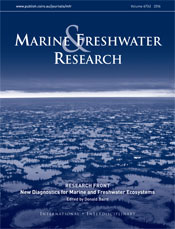Marine and Freshwater Research
Volume 67
Number 4 2016
RESEARCH FRONT: New Diagnostics for Marine and Freshwater Ecosystems
Marine and freshwater ecosystem degradation is invariably associated with the presence of multiple stressors. A workshop held in Sydney, Australia, in September 2014 explored the application of new ecosystem observation technologies, and how their systematic application can support improved understanding of the complex causes of ecosystem change, and humanity’s role as a significant driver of that change.
Advances in computing speed, coupled with new earth observation technologies, have increased the use of molecular and remote sensing tools in monitoring. We critique a range of data types from these tools and explore how they can be used to assess ecosystem health. We highlight challenges, but also opportunities for these data sources to revolutionise monitoring in the future.
Aquatic ecosystems are subject to multiple stressors. This paper extends the current Environmental Risk Assessment framework using environmental-genomic data to examine the effects of multiple stressors across multiple levels of biological organisation. We consider how these and other emerging data sources may be combined and analysed using new statistical approaches for disentangling the effects of multiple stressors.
To assess the ecological risks of multiple stressors, future risk assessments should include cultural and ecological protection goals, the development of ecological scenarios, the relevant interactions among species, potential sources of stressors and their interactions and the development cause–effect models. For this, the application of new and emerging tools such as ‘big data’, ecological modelling and the incorporation of ecosystem service endpoints is needed.
Selecting reference sites in highly modified landscapes is a key challenge for stream bioassessment practitioners. In this case study, generalised dissimilarity modelling was used to model fish species turnover as a function of GIS-based environmental variables to delineate ‘ecotypes’, identify influential human pressure variables and define and map candidate reference conditions. The method is transparent, indicator-specific and efficient, and complements existing procedures for defining reference conditions.
Disease surveys on coral and crustose coralline algae were conducted on reefs in New Caledonia in 2010 and 2013. Thirty coral diseases affecting 15 coral genera were found with low overall disease prevalence (<1%). New host and biogeographic range extensions were found for several diseases including trematode infection in Porites. The potential ecological impact of individual coral diseases were assessed using an integrative scoring and relative ranking scheme.
Concerns about global climate change have heightened the role changing rainfall regimes play in altering plankton communities. In this study spatial and temporal patterns of phytoplankton composition and biomass in a sub-tropical tidal creek in Florida were observed over three wet and dry seasons. The results are discussed within the context of how variability in rainfall influence water residence times, nutrient concentrations and salinity regimes, which in turn influence phytoplankton.
Functions of tropical soda lakes depend heavily on algae, particularly Arthrospira, which are the basis for understanding their ecological integrity. This study, which aimed at investigating the algal dynamics in one of the fragile tropical soda lakes, revealed the occurrence of considerable seasonality of algal biomass and Arthrospira abundance following changes in environmental factors. This suggests that algal seasonality may greatly affect the values of soda lakes.
Temporally high-frequency sampling was performed to examine rapid changes in the community composition of estuarine tintinnid ciliates. The dominant tintinnid species changed largely within several days due to changes in environmental and biological conditions. However, most tintinnid species were less vulnerable to predation pressure by copepods probably because there were many alternate prey to these predators.
This study represents the first investigation into the impact of elevated suspended sediment concentrations on the diving behaviour of a bimodally respiring, freshwater turtle (Elseya irwini). Our data demonstrate that increased suspended sediment directly affects the utilisation of aquatic respiration by this species to extend submergence times under optimal conditions. These observations raise concerns about the effects of erosion and catchment land management practices, on the long term sustainability of physiologically specialised freshwater turtle populations.
Declining shark stocks have emphasised the need for a greater understanding of commercially targeted species. Here we assess the reproductive biology of dusky, spinner and sandbar sharks in eastern Australian waters, where all three were found to be late maturing and of low reproductive output, indicative of a low resilience to fishing pressure. This research reinforces the importance of locally-derived parameters for stock assessment.
Amphidromous species represent a substantial part of freshwater fish diversity throughout the Indo-Pacific region, but knowledge of their life-history traits remains scarce. The reproductive biology of an endemic goby was investigated highlighting a high reproductive effort with multiple opportunities of spawning regulated by environmental cues. Knowledge of these demographic traits is essential for evaluate the species resilience and improve management strategy of insular rivers.




